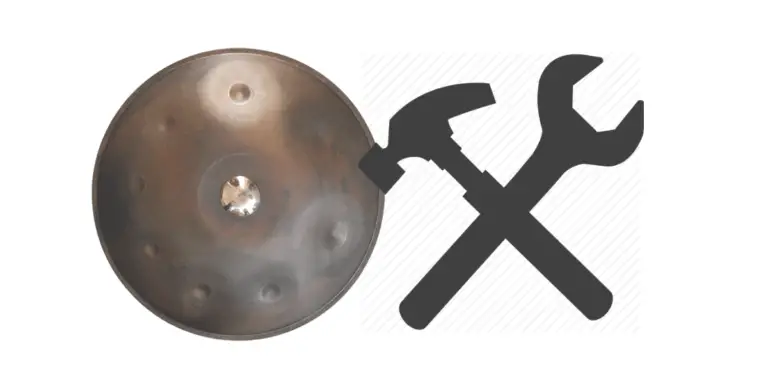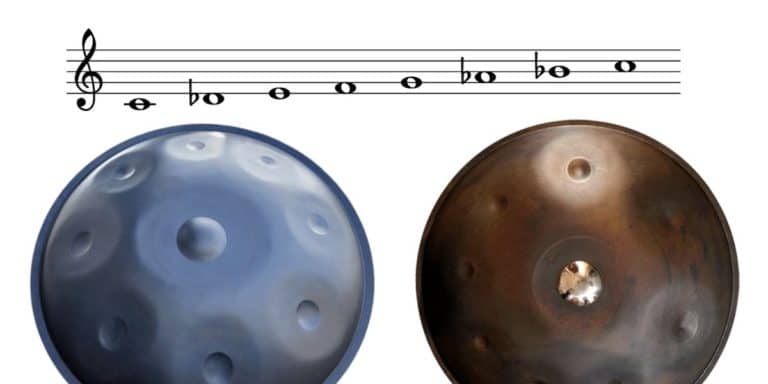How Does a HandPan Work? Scale, Material, and Troubleshooting
If you have arrived looking for how a handpan works then you’ve certainly seen one and wondered the same as me. How can a handpan make such beautiful music?
How does a handpan work? – Due to the manipulation of the nitrided steel into a specific shape, it has dimples tuned to a diatonic scale. When struck, the dimples sound the notes. The sound is created by affecting the air inside, released via a hole located in the bottom half of the pan. They are tuned, mostly, to a single scale, so even without musical knowledge; almost anyone can make beautiful music with a well-tuned handpan.

There is so much more to a handpan and I had to look further into how they are created and if I wanted a 440hz or 432hz tuning. The deeper I got the more I wanted to know.
How Does a Handpan make a Sound?
The sound a handpan makes are simply vibrations of the tone fields created on the surface on the handpan.
Each membrane will be of a different size. The larger the field, the deeper or lower the note. The smaller, the higher-pitched the note will be.
Notes resonate in the void of the two halves, are naturally amplified and released through the hole at the bottom.
..an instrument associated with energy work and alternative healing,
Daniel Waples
Tunes are created by striking the upper part of the handpan with your hands. Fingers and thumbs or other parts of your hands hitting the various notes create the sounds.
The upper side of the handpan will contain all of the notes. Known as dimples, they are inverted depressions of the steel to particular sizes. When struck, it creates a sound.
In most cases, the lower section will be plain, without dimples, with a hole at the bottom, which releases the sound, the notes, made from striking the upper part around the dimples.
You can, however, find or request additional notes on the bottom section. Just two more notes provide more variation to the possible melodies available.
What is the Diatonic Scale?
A diatonic scale has seven pitches. It includes five whole tones and two semitones for each octave.
Taking a 7+1 handpan, that is, seven notes and the ding. You can see how simple it is to have a perfect diatonic scale applied to the instrument.
Of course, handpans are not limited to these notes. Instruments with more are frequently produced. You will find them generally more expensive. The more notes, the bigger the margin for error with tuning, and it can, from a poor manufacturer, see the sharpest notes, quite quiet.
Does a Handpan Only Work With Hands?
The name gives it away, but there is a range of accessories that can be purchased to play your handpan.
Using gloves when playing handpan
First up are gloves. You are still playing with your hands, but the gloves provide changes in the sound of your instrument. The notes are detectably shorter, slightly dulled, and the volume will be lower.
Can you use mallets to play a handpan?
Yes, you can play your handpan with mallets. I wouldn’t recommend it, however, and less very light and soft. Your handpan will detune much quicker. Different buffers on the sticks produce different sounds and resonance. For me, though, I don’t know. It feels like going back to a steel drum and I want my tuning to last.
So, A Handpan is Like a Drum?
In one way, it is similar in that striking the pan creates the sound and the notes, but unlike a drum, the steel is not producing the notes based on being under tension.
It is quite the opposite, whereby the steel note areas are under what is known as compressive stress. That is, the steel is pushing out. Effectively the steel is buckled. Each note is an area carefully buckled to a specific degree — each note working in harmony with the others within a particular scale.
Not only do you have the note as tunes, but by a very skilled process, harmonics are introduced to richen the sound further. Also providing the distinctive vibrating frequencies.
Tuned to a specific scale, handpans are most often created to order with a fair waiting list. With luck, occasionally they become available off the shelf. Perfect if you happen to desire an available scale.
How Long Does It Take to Learn?
It is all very well owning one, but to make a handpan work, you will have to learn how to play. Thankfully, unlike most musical instruments, the beauty of a handpan is that within one hour, you will be making music. It is very unlikely you will be out of tune, especially if you have bought a good one.
It may take you one hour to get the ‘feel’ for your handpan and to strike it correctly. After that time, you will begin to understand the basic striking process through trial and error.
Practice using your fingertips, the knuckle in your thumb, and the heel of your hand. Different ways of playing notes with small subtleties become apparent. You’ll be making beautiful music in no time.
Consider a video course on how to play the handpan. In this day and age, video courses are easily accessible, inexpensive for the long term value to be gained, and a convenient way to apportion your own time to when you want to learn.
Feel free to explore Youtube. There are a great many videos with tips, tricks, and guides on how to play. But experimentation works best. You’ll be surprised how quickly you will make music.
How does a handpan work with 440hz or 432hz?
Ok, we are getting a bit technical here, but it is very relevant.
Most instruments tune to 440hz, but many handpan players like or would like to tune to 432hz.
I shan’t get into the theories of 432hz. If you have any idea what I am talking about now, you will already be aware.
The handpan is a very spiritual instrument. While playing, it is possible to gain a feeling of becoming one with nature. There is a belief that 432hz tuning has healing properties. It can soothe and intrinsically connect to the vibrations of life and nature.
Can you hear the difference? Hardly but you may ‘feel’ it!
What is Nitrided Steel?
The handpan will be crafted from nitrided steel and comprises of two bowl shapes glued together. Often people say they look like UFOs or Turtles. Imagine two woks held together at the fullest part. You get the idea.
Nitrided steel is used most often, although not exclusively in handpans because it is easy to work on, and tuning is more stable.
When steel is nitrided, it means it has undergone a heat-treating process. The process creates a hardened surface by diffusing nitrogen into the surface.
By hardening the surface, it improves the result of the compressive stress added to create the resonance of the notes of the handpan.
As well as hardening the steel to protect it, the process also improves resistance to corrosion and rust.
My Handpan Doesn’t Work!
Attempt to diagnose precisely what the problem is. What are you experiencing compared to what you are expecting?
- Does it sound out of tune?
- Is the sound muffled?
- Are the two hemispheres coming apart?
- Has it been dropped or damaged in some way?
- Is corrosion apparent on your handpan?
Youtube again can answer many of your queries. Some videos can help with diagnosis, but beware there is some advice that can be specific to particular makes of handpan.
If your problem seems to be a major one and you are unable to get your handpan to work in the way you expect, it is probably best to get in touch with the manufacturer. They may be able to help without seeing your pan but will perhaps like to see it for themselves and offer a solution.
If they are out of reach, logistically ask around the online community for more advice.







